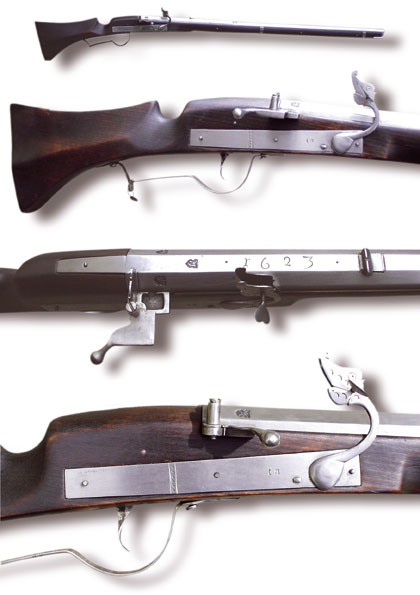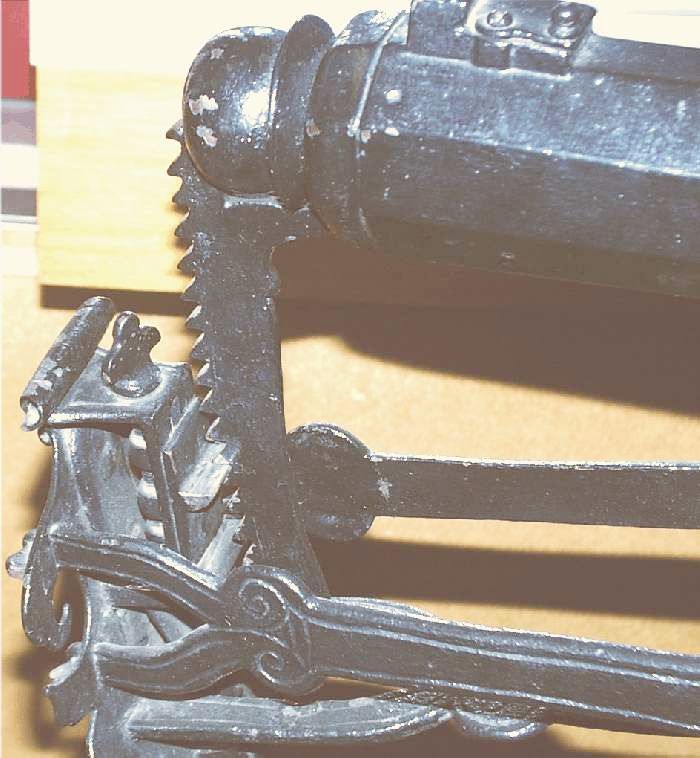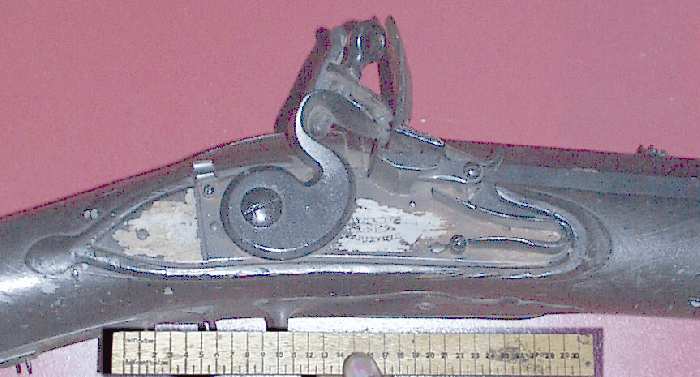-
Friends, our 2nd Amendment rights are always under attack and the NRA has been a constant for decades in helping fight that fight.
We have partnered with the NRA to offer you a discount on membership and Muzzleloading Forum gets a small percentage too of each membership, so you are supporting both the NRA and us.
Use this link to sign up please; https://membership.nra.org/recruiters/join/XR045103
You are using an out of date browser. It may not display this or other websites correctly.
You should upgrade or use an alternative browser.
You should upgrade or use an alternative browser.
most powefull flintlock musket
- Thread starter agent00
- Start date

Help Support Muzzleloading Forum:
This site may earn a commission from merchant affiliate
links, including eBay, Amazon, and others.
There were special "wall guns" which could sort of qualify as muskets I guess. These were large-bored (like 1") and thick-walled and strongly stocked guns with a swivel mounted that could be inserted in a hole in a post and fired from the shoulder. Some were rifled, sone were smooth.
Among military muskets carried by troops and firing round ball, there was no particular advantage of one model over another as far as power was concerned. It's in how they were loaded.
The emergence of minie balls (elongated bullets) before the Civil War increased the energy and power downrange of muskets.
Among military muskets carried by troops and firing round ball, there was no particular advantage of one model over another as far as power was concerned. It's in how they were loaded.
The emergence of minie balls (elongated bullets) before the Civil War increased the energy and power downrange of muskets.
I'm now wondering if "musket" implies shoulder fired. Webster defines it as such, so any swivel mount or wall hook would disqualify the beast.
"Military" disqualifies the punt guns and African four-bores of sporting use.
Blunderbusii have huge bores, well over 1", but not enough barrel wall to support an equally huge powder charge.
Here's reference to a c. 1630 Shul matchlock musket of "8 balls to the pound" (875 gr round ball!) that was probably no fun at all to shoot. Used at the castle of Coburg (the military requirement).

"Military" disqualifies the punt guns and African four-bores of sporting use.
Blunderbusii have huge bores, well over 1", but not enough barrel wall to support an equally huge powder charge.
Here's reference to a c. 1630 Shul matchlock musket of "8 balls to the pound" (875 gr round ball!) that was probably no fun at all to shoot. Used at the castle of Coburg (the military requirement).

I'm now wondering if "musket" implies shoulder fired. Webster defines it as such, so any swivel mount or wall hook would disqualify the beast.
"Military" disqualifies the punt guns and African four-bores of sporting use.
Blunderbusii have huge bores, well over 1", but not enough barrel wall to support an equally huge powder charge.
Here's reference to a c. 1630 Shul matchlock musket of "8 balls to the pound" (875 gr round ball!) that was probably no fun at all to shoot. Used at the castle of Coburg (the military requirement).
[url] http://www.engerisser.de/Bewaffnung/weapons/Matchlockmusket.html[/url]

But that ain't a flintlock. :haha:
The Dutch used a .78 cal musket in the 1760's and that is as large as I have come across for a "issued" musket. It made good sense to standardize the caliber, and humans are only so big, so the 3/4" +/- seems to be the norm for the flint era. Bigger than that you didn't fire it from your shoulder.
"Military" disqualifies the punt guns and African four-bores of sporting use.
Blunderbusii have huge bores, well over 1", but not enough barrel wall to support an equally huge powder charge.
Here's reference to a c. 1630 Shul matchlock musket of "8 balls to the pound" (875 gr round ball!) that was probably no fun at all to shoot. Used at the castle of Coburg (the military requirement).
[url] http://www.engerisser.de/Bewaffnung/weapons/Matchlockmusket.html[/url]

But that ain't a flintlock. :haha:
The Dutch used a .78 cal musket in the 1760's and that is as large as I have come across for a "issued" musket. It made good sense to standardize the caliber, and humans are only so big, so the 3/4" +/- seems to be the norm for the flint era. Bigger than that you didn't fire it from your shoulder.
Last edited by a moderator:
Wall guns were fired from the shoulder, but recoil was so severe that the yoke, or a hook that fit over the top of the wall absorbed the recoil.
There have been reports of 18th century wall guns constently hitting men at ranges in excess of 600 yards.
Considering a one inch + diameter ball, fired with a relatively flat trajectory, powder charges must have been excessive. I seem to remember reading that a 600 gr powder charge was somewhat common.
That said, wall guns were probably considered specaillized artillery, as opposed to run of the mill muskets.
J.D.
There have been reports of 18th century wall guns constently hitting men at ranges in excess of 600 yards.
Considering a one inch + diameter ball, fired with a relatively flat trajectory, powder charges must have been excessive. I seem to remember reading that a 600 gr powder charge was somewhat common.
That said, wall guns were probably considered specaillized artillery, as opposed to run of the mill muskets.
J.D.
I would put in a vote for the British volley gun.Saw one in the museum in Calgery and it is a multi barreled flintlock that fired all barrels at once.Very impressive...as would be the fellow who carried and shot it as well. :bow:
I believe some of the earlier muskets were 10 to 8 bore and use a forked support stick to fire and were shot from the shoulder, the lighter arquebus was used in the same manner but was of a smaller bore .75 or so this is 15th and 16th century era, later the musket became a heavier shoulder arm of military use and the arquebus the lighter forerunner of the trade or hunting gun from what I have came to understand.
Guest
There have been reports of 18th century wall guns constently hitting men at ranges in excess of 600 yards.
Do you know what gun type this quote refers to? The martial 18th century wall guns I saw so far were smoothbores, often even without rear sight. Really preceise wall guns came out in the 19th century, e.g. the bavarian M1831 which is my personal favorite.
- Joined
- May 24, 2005
- Messages
- 5,338
- Reaction score
- 4,989
Some of the U.S. made Committee of Safety muskets were .80 caliber.
Robert/Sfl,
there is an American wall piece with rear sight listed in the "Arms and Armor in Colonial America 1526-1783" by Harold Peterson. I have another book with a couple early American wall pieces as well that are rifled (I can't find it). Most of the British wall guns seemed to be smooth.
there is an American wall piece with rear sight listed in the "Arms and Armor in Colonial America 1526-1783" by Harold Peterson. I have another book with a couple early American wall pieces as well that are rifled (I can't find it). Most of the British wall guns seemed to be smooth.
Peterson's "Book of the Continental Soldier", page 55 quotes a letter from General Charles Lee, reporting that a recently acquired rifle-amusette, firing a two ounce ball, hit a half sheet of paper at 500 yards. I don't know how large a half sheet of paper was, but it must have been somewhat smaller than a man size target, because Lee appeared to be impressed with its accuracy.
I have also seen references to smooth bored wall guns exhibiting excellent accuracy at extreme ranges, but couldn't find that source.
J.D.
I have also seen references to smooth bored wall guns exhibiting excellent accuracy at extreme ranges, but couldn't find that source.
J.D.
robinghewitt
62 Cal.
- Joined
- Jun 26, 2004
- Messages
- 2,605
- Reaction score
- 20
J.D. said:There have been reports of 18th century wall guns constently hitting men at ranges in excess of 600 yards.
Once your bore reaches 1" the gun takes on cannon attributes and starts to get accurate. I've only tried ball in my 1790 wall gun one time but I was impressed.
Here's the screw elevation adjuster from a 17th century, civil war Rabonet in 1.5", you can see that it is a precision instrument. In fact they were so accurate there had to be an agreement that neither side would pick off the other side's officers :thumbsup:

Hi, its me again, with a new historical question: what was the most powerfull military flinlock musket? Was there a musket more powerfull/ effectiv than others, or where all muskets equal in power?
As far as raw power goes, there probably wasn't a large difference between the muskets employed by the various military forces.
I personally lean toward the Brown Bess variants as the most powerful musket, after all it was in the hands of the army that conquered the world's largest empire for over a century.
However the power of the musket itself was not a major factor as for much of the time it was in use the English Army relied primarily on the bayonet as the decisive weapon of warfare.
Guest
I do not have a good digital picture but I recently found one at an auction; that piece is not in best shape, but you can see the general style:
M1831 Wallgun
As you see, it looks rather civil which is the reason it is often not recognized (even in a museum brochure that I read once is was refered to as heavy civil target rifle).
The caliber is 22,9mm, weight 12kg, barrel length 91cm. An old report mentions a powder charge of 12/16 loth or about 185 grains if I calculated right. These guns were also used for the first trials with various bullet types in the 1840s.
M1831 Wallgun
As you see, it looks rather civil which is the reason it is often not recognized (even in a museum brochure that I read once is was refered to as heavy civil target rifle).
The caliber is 22,9mm, weight 12kg, barrel length 91cm. An old report mentions a powder charge of 12/16 loth or about 185 grains if I calculated right. These guns were also used for the first trials with various bullet types in the 1840s.
robinghewitt
62 Cal.
- Joined
- Jun 26, 2004
- Messages
- 2,605
- Reaction score
- 20
I just found this pic I took, that's a one foot ruler :grin:


Similar threads
- Replies
- 3
- Views
- 251
- Replies
- 0
- Views
- 294
- Replies
- 2
- Views
- 320
Latest posts
-
-
-
-
-
-
-
-
-
Edenton Historical Commission articles on hunting bags and accoutrements
- Latest: PathfinderNC




